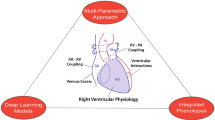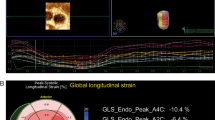Abstract
Background
Quantitative evaluation of right ventricular myocardial performance in preterm infants remains a challenge because of the limitations of conventional echocardiographic measurement and the complex geometry of the right ventricle (RV). Serial assessment of peak longitudinal systolic strain on the right and left sides of the ventricular septum (VS), RV, and left ventricle (LV) during the transitional period in preterm infants using two-dimensional speckle-tracking echocardiography is reported.
Methods
In 21 preterm infants (33 ± 2 gestational weeks, 1,913 ± 218 g birth weight) without mechanical ventilation, inotropic agents, or symptomatic patent ductus arteriosus (PDA), longitudinal strain (LS) was measured on both sides of the VS, RV free wall, and LV, along with conventional echocardiography at 1, 3, 6, 9, 12, 24, 48, and 72 h after birth. Correlations and factors associated with echocardiographic measurements were analyzed.
Result
LS was maintained on the four analyzed regions during the first 72 h of life despite significant hemodynamic changes, including a decrease in pulmonary artery pressure and PDA closure. LS was significantly larger on the left side of the VS than on the right side of the VS at 1, 48, and 72 h after birth.
Conclusions
Preterm infants showed stable LS on both sides of the VS, the RV free wall, and the LV despite significant hemodynamic changes during the first 72 h of life. These results suggest that the right and left sides of the VS respond differently to the complex cardiopulmonary transitions from fetal to neonatal life in preterm infants.




Similar content being viewed by others
References
Kluckow M, Seri I. Clinical presentations of neonatal shock: the very low birth weight neonate during the first postnatal day. In: Kleinman CS, Seri I, Polin RA editors. Hemodynamics and Cardiology. Neonatology Questions and Controversies. 2nd ed. Philadelphia, Elsevier Saunders; 2012. pp. 237-67.
El-Khuffash AF, Jain A, Dragulescu A, et al. Acute changes in myocardial systolic function in preterm infants undergoing patent ductus arteriosus ligation: a tissue Doppler and myocardial deformation study. J Am Soc Echocardiogr. 2012;25:1058–67.
Lee A, Nestaas E, Liestol K, et al. Tissue Doppler imaging in very preterm infants during the first 24 h of life: an observational study. Arch Dis Child Fetal Neonatal Ed. 2014;99:F64–9.
James AT, Corcoran JD, Jain A, et al. Assessment of myocardial performance in preterm infants less than 29 weeks gestation during the transitional period. Early Hum Dev. 2014;90:829–35.
Boettler P, Claus P, Herbots L, et al. New aspects of the ventricular septum and its function: an echocardiographic study. Heart. 2005;91:1343–8.
Hayabuchi Y, Sakata M, Ohnishi T, et al. A novel bilayer approach to ventricular septal deformation analysis by speckle tracking imaging in children with right ventricular overload. J Am Soc Echocardiogr. 2011;24:1205–12.
Hayabuchi Y, Sakata M, Kagami S. Assessment of the helical ventricular myocardial band using standard echocardiography. Echocardiography. 2014. doi:10.1111/echo.12624.
Di Salvo G, Russo MG, Paladini D, et al. Two-dimensional strain to assess regional left and right ventricular longitudinal function in 100 normal fetuses. Eur J Echocardiogr. 2008;9:754–6.
Schubert U, Müller M, Norman M, et al. Transition from fetal to neonatal life: changes in cardiac function assessed by speckle-tracking echocardiography. Early Hum Dev. 2013;89:803–8.
Jain A, Mohamed A, El-Khuffash A, et al. A comprehensive echocardiographic protocol for assessing neonatal right ventricular dimensions and function in the transitional period: normative data and Z scores. J Am Soc Echocardiogr. 2014;27:1293–304.
Levy PT, Holland MR, Sekarski TJ, et al. Feasibility and reproducibility of systolic right ventricular strain measurement by speckle-tracking echocardiography in premature infants. J Am Soc Echocardiogr. 2013;26:1201–13.
Singh GK, Cupps B, Pasque M, et al. Accuracy and reproducibility of strain by speckle tracking in pediatric subjects with normal heart and single ventricular physiology: a two-dimensional speckle-tracking echocardiography and magnetic resonance imaging correlative study. J Am Soc Echocardiogr. 2010;23:1143–52.
Friedman WF. The intrinsic physiologic properties of the developing heart. Prog Cardiovasc Dis. 1972;15:87–111.
Rudolph AM. Congenital diseases of the heart. Clinical-physiological considerations. 3rd ed. West Sussex: Wiley-Blackwell: 2009.
Rudski LG, Lai WW, Afilalo J, et al. Guidelines for the echocardiographic assessment of the right heart in adults: a report from the American Society of Echocardiography. Endorsed by the European Association of Echocardiography, a registered branch of the European Society of Cardiology, and the Canadian Society of Echocardiography. J Am Soc Echocardiogr. 2010;23:685–713.
Mertens L, Seri I, Marek J, et al. Targeted neonatal echocardiography in the neonatal intensive care unit: practice guidelines and recommendations for training. Writing group of the American Society of Echocardiography (ASE) in collaboration with the European Association of Echocardiography (EAE) and the Association for European Pediatric Cardiologists (AEPC). J Am Soc Echocardiogr. 2011;24:1057–78.
Koestenberger M, Ravekes W, Everett AD, et al. Right ventricular function in infants, children and adolescents: reference value of the tricuspid annular plane systolic excursion (TAPSE) in 640 healthy patients and calculation of z score values. J Am Soc Echocardiogr. 2009;22:715–9.
Kitabatake A, Inoue M, Asao M, et al. Noninvasive evaluation of pulmonary hypertension by a pulsed doppler technique. Circulation. 1983;68:302–9.
Mejia AAS, Simpson KE, Hildebolt CF, et al. Tissue Doppler septal Tei index indicates severity of illness in pediatric patients with congestive heart failure. Pediatr Cardiol. 2014;35:411–8.
Colan SD, Shirali G, Margossian R, et al. The ventricular volume variability study of the pediatric heart network: study design and impact of beat averaging and variable type on the reproducibility of echocardiographic measurements in children with chronic dilated cardiomyopathy. J Am Soc Echocardiogr. 2012;25:842–54.
Beyar R, Dong SJ, Smith ER, et al. Ventricular interaction and septal deformation: a model compared with experimental data. Am J Physiol. 1993;265:2044–56.
Evans N, Iyer P. Assessment of ductus arteriosus shunt in preterm infants supported by mechanical ventilation: effect of interatrial shunting. J Pediatr. 1994;125:778–85.
Haruki N, Takeuchi M, Kanazawa Y, et al. Continuous positive airway pressure ameliorates sleep-induced subclinical left ventricular systolic dysfunction: demonstration by two-dimensional speckle-tracking echocardiography. Eur J Echocardiogr. 2010;11:352–8.
Hammerstingl C, Schueler R, Wiesen M, et al. Impact of untreated obstructive sleep apnea on left and right ventricular myocardial function and effects of CPAP therapy. PLoS ONE. 2013. doi:10.1371/journal.pone.0076352.
Franchi F, Faltoni A, Cameli M, et al. Influence of positive end-expiratory pressure on myocardial strain assessed by speckle tracking echocardiography in mechanically ventilated patients. BioMed Res Int. 2013. doi:10.1155/2013/918548.
Fukuda Y, Tanaka H, Sugiyama D, et al. Utility of right ventricular free wall speckle-tracking strain for evaluation of right ventricular performance in patients with pulmonary hypertension. J Am Soc Echocardiogr. 2011;24:1101–8.
Giusca S, Dambrauskaite V, Scheurwegs C, et al. Deformation imaging describes right ventricular function better than longitudinal displacement of the tricuspid ring. Heart. 2010;96:281–8.
Torrent-Guasp F, Ballester M, Buckberg GD, et al. Spatial orientation of the ventricular muscle band: physiologic contribution and surgical implication. J Thorac Cardiovasc Surg. 2001;122:389–92.
Levy PT, Mejia AAS, Machefsky A, et al. Normal ranges of right ventricular systolic and diastolic strain measures in children: a systematic review and meta-analysis. J Am Soc Echocardiogr. 2014;27:549–60.
Takigiku K, Takeuchi M, Izumi C, et al. Normal range of left ventricular 2-dimensional strain: Japanese Ultrasound Speckle Tracking of the Left Ventricle (JUSTICE) study. Circ J. 2012;76:2623–32.
Acknowledgment
This study was approved by the institutional review board of Iwate Medical University (H25-63).
Conflict of interest
Yurie Nasu, Kotaro Oyama, Satoshi Nakano, Atsushi Matsumoto, Wataru Soda, Shin Takahashi, and Shoichi Chida declare that they have no conflict of interest.
Human rights statement and informed consent
All procedures followed were in accordance with the ethical standards of the institutional review board of Iwate Medical University and with the Helsinki Declaration of 1975, as revised in 2000. Informed consent was obtained from the parents of all subjects prior to enrolment.
Author information
Authors and Affiliations
Corresponding author
Rights and permissions
About this article
Cite this article
Nasu, Y., Oyama, K., Nakano, S. et al. Longitudinal systolic strain of the bilayered ventricular septum during the first 72 hours of life in preterm infants . J Echocardiogr 13, 90–99 (2015). https://doi.org/10.1007/s12574-015-0250-8
Received:
Revised:
Accepted:
Published:
Issue Date:
DOI: https://doi.org/10.1007/s12574-015-0250-8




